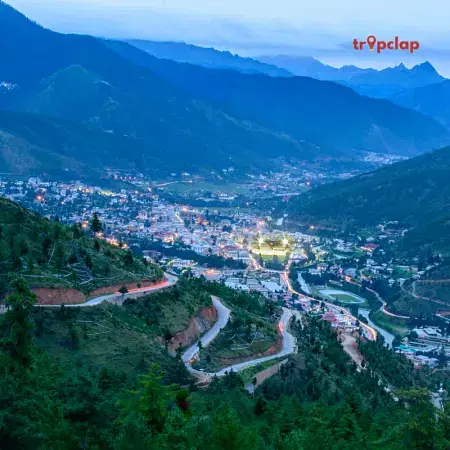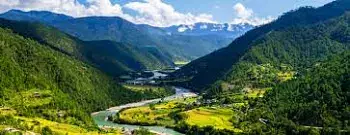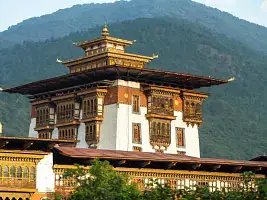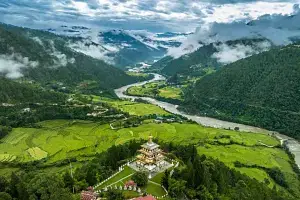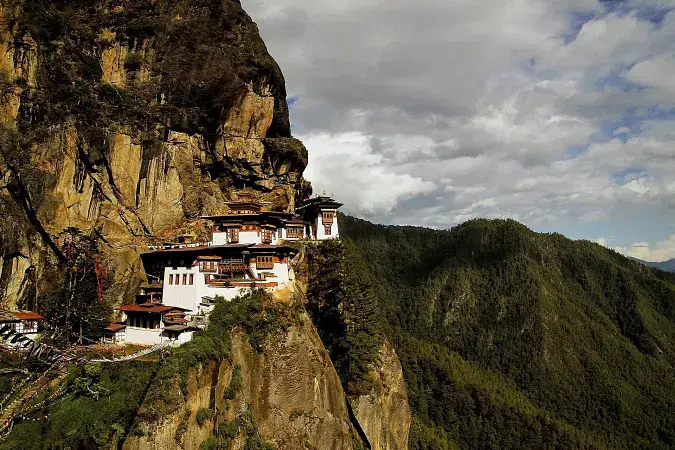
Bhutan
Package
10500 to 40000
10500 to 40000
Duration
5 to 10 Days
5 to 10 Days
Best time to visit
Mar-May, Sep-Nov
Mar-May, Sep-Nov
Theme
Hill Station, Adventure, Religious
Hill Station, Adventure, Religious
Bhutan Travel Guide
Bhutan, located in the eastern Himalayas, is a small landlocked country known for its stunning landscapes, ancient monasteries, and unique culture. With a strong emphasis on preserving its traditions and environment, Bhutan offers visitors a glimpse into a world untouched by modernity. The country's rich history, breathtaking scenery, and vibrant festivals make it a must-visit destination for those seeking an authentic and enriching travel experience.Top Attractions in Bhutan
1. Tiger's Nest Monastery 2. Punakha Dzong 3. Dochula Pass 4. Phobjikha Valley 5. Paro ValleyBhutan is Famous for
Bhutan is famous for its Gross National Happiness index, stunning monasteries, and beautiful landscapes.Top Attractions in Bhutan
- Tiger's Nest Monastery - Punakha Dzong - Dochula Pass - Phobjikha Valley - Paro ValleyWhat's Great about Travelling to Bhutan?
- Experience a unique and preserved culture - Explore breathtaking Himalayan landscapes - Participate in colorful local festivals - Enjoy a peaceful and tranquil environmentWhat's Not So Great about Travelling to Bhutan?
- Limited tourist infrastructure - High daily tariff for tourists - Remote locations and challenging terrain - Limited nightlife and entertainment optionsTravel Tips for Bhutan
- Obtain a visa in advance through a registered tour operator - Respect local customs and traditions - Be prepared for high altitude in certain regions - Dress modestly when visiting religious sitesImportant Bhutan trip information
- Ideal Duration: A week to 10 days is ideal to explore the major attractions.
- Best Time to Visit: Spring and autumn are the best seasons to visit for pleasant weather.
- Nearby Airports and Railway Stations: Paro International Airport is the main airport, and there are no railway stations in Bhutan.
Top 11 Places to visit in Bhutan
Per Person
28,500
*EXCLUDING APPLICABLE TAXES 5.0 Ratings
( 21 Reviews )
( 21 Reviews )
Per Person
29,700
*EXCLUDING APPLICABLE TAXES 5.0 Ratings
( 21 Reviews )
( 21 Reviews )
Per Person
42,999
*EXCLUDING APPLICABLE TAXES 4.8 Ratings
( 95 Reviews )
( 95 Reviews )
Per Person
32,500
*EXCLUDING APPLICABLE TAXES 5.0 Ratings
( 21 Reviews )
( 21 Reviews )
Per Person
20,300
*EXCLUDING APPLICABLE TAXES 4.6 Ratings
( 53 Reviews )
( 53 Reviews )
Per Person
32,000
*EXCLUDING APPLICABLE TAXES 5.0 Ratings
( 21 Reviews )
( 21 Reviews )
FAQ's on Bhutan
Q1: What is the best time to visit Bhutan?
The best time to visit Bhutan is during the spring months of March to May and the fall months of September to November. These periods offer pleasant weather with clear skies, making it ideal for exploring the stunning landscapes and attending cultural festivals. However, each season has its charm, so it ultimately depends on your preferences.
Q2: Do I need a visa to travel to Bhutan?
Yes, tourists visiting Bhutan require a visa. Travelers must book their trip through a licensed Bhutanese tour operator who will arrange the visa on their behalf. The visa processing is included in the tour cost. Additionally, visitors must pay a daily tariff set by the government, which covers accommodation, meals, transportation, and guide services. It is advisable to check with the tour operator for specific requirements and exceptions.
Q3: What are the must-visit attractions in Bhutan?
Bhutan is known for its breathtaking monasteries such as Tiger’s Nest Monastery, Punakha Dzong, and Rinpung Dzong. The Paro Valley, Thimphu, and the Phobjikha Valley are popular destinations offering stunning landscapes and rich cultural experiences. Don’t miss the vibrant festivals like Paro Tshechu and Thimphu Tshechu, showcasing Bhutanese traditions. Nature lovers can explore the serene Haa Valley and the Chele La Pass for panoramic views. Bhutan’s unique blend of nature and culture makes every place worth visiting.
Q4: Is Bhutan a safe place to travel?
Bhutan is considered a safe travel destination with low crime rates. However, travelers should still exercise caution, especially in crowded areas and when venturing into remote regions. It is advisable to follow basic safety precautions like safeguarding your belongings and staying informed about local customs. While Bhutan is generally safe, it’s recommended to respect the local traditions and be mindful of cultural sensitivities to ensure a smooth and enjoyable trip.
Q5: What is the local currency in Bhutan and can I use credit cards?
The official currency of Bhutan is the Bhutanese Ngultrum (BTN), which is at par with the Indian Rupee. While credit cards are accepted in some hotels and larger shops in urban areas like Thimphu and Paro, it’s recommended to carry cash for smaller transactions and in rural areas where card facilities may be limited. ATMs are available in major towns, but it’s advisable to withdraw cash in advance as they may not always be reliable.
Q6: What is the local cuisine like in Bhutan?
Bhutanese cuisine is known for its spicy flavors and unique dishes like Ema Datshi (chili and cheese stew), Phaksha Paa (pork with red chilies), and Jasha Maru (spicy minced chicken). Rice is a staple in every meal, accompanied by various side dishes. Local markets offer fresh produce, and you can savor traditional Bhutanese dishes at local eateries called "restaurants." For those with dietary restrictions, it’s advisable to inform the hosts in advance, as Bhutanese cuisine can be quite spicy. Trying the local cuisine is a delightful way to experience the culture and flavors of Bhutan.
Q7: What transportation options are available in Bhutan?
In Bhutan, transportation options include taxis, buses, and rental cars. Taxis are readily available in urban areas, while buses connect major towns and districts. Renting a car with a driver is a popular choice for exploring the country independently. Roads in Bhutan are scenic but can be narrow and winding, so it’s advisable to hire a local driver who is familiar with the terrain. Additionally, domestic flights operate between Paro and Bumthang for those looking to save time on long journeys. Travelers can choose the mode of transportation based on their itinerary and comfort preferences.
Q8: Are there any cultural norms or etiquette I should be aware of when visiting Bhutan?
When visiting Bhutan, it’s important to respect local customs and traditions. Dress modestly, especially when visiting religious sites and government buildings. Always ask for permission before taking photographs, especially of people. It’s customary to greet locals with a slight bow and a "Kuzuzangpo La" (hello) as a sign of respect. Avoid pointing at people or religious objects, and be mindful of your actions in sacred places like monasteries and temples. Taking off your shoes before entering someone’s home is a common practice. By being respectful and open to learning about Bhutanese customs, you can have a more enriching and meaningful cultural experience during your visit.
Q9: I am a travel agent. How can I buy travel leads of Bhutan?
Register yourself as a travel agent at agents.tripclap.com and then you can buy travel leads to Bhutan once your account is approved. For more details contact our support team at +91-8069186564 or support@tripclap.com
